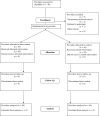A cluster randomized clinical trial to improve prescribing patterns in ambulatory pediatrics
- PMID: 17525793
- PMCID: PMC1876598
- DOI: 10.1371/journal.pctr.0020025
A cluster randomized clinical trial to improve prescribing patterns in ambulatory pediatrics
Abstract
Objectives: Having shown previously that an electronic prescription writer and decision support system improved pediatric prescribing behavior for otitis media in an academic clinic setting, we assessed whether point-of-care delivery of evidence could demonstrate similar effects for a wide range of other common pediatric conditions.
Design: Cluster randomized controlled trial.
Setting: A teaching clinic/clinical practice site and a primary care pediatric clinic serving a rural and semi-urban patient mix.
Participants: A total of 36 providers at the teaching clinic/practice site and eight providers at the private primary pediatric clinic.
Intervention: An evidence-based message system that presented real-time evidence to providers based on prescribing practices for acute otitis media, allergic rhinitis, sinusitis, constipation, pharyngitis, croup, urticaria, and bronchiolitis.
Outcome measures: The proportion of prescriptions dispensed in accordance with evidence.
Results: The proportion of prescriptions dispensed in accordance with evidence improved four percentage points, from 38% at baseline to 42% following the intervention. The control group improved by one percentage point, from 39% at baseline to 40% at trial's conclusion. The adjusted difference between the intervention and control groups was 8% (95% confidence interval 1%, 15%). Intervention effectiveness did not decrease with time.
Conclusion: For common pediatric outpatient conditions, a point-of-care evidence-based prescription writer and decision support system was associated with significant improvements in prescribing practices.
Conflict of interest statement
Figures
References
-
- Committee on Quality of Health Care in America. Crossing the quality chasm: A new health system for the 21st century. Washington (D. C.): Institute of Medicine; 2001. 364
-
- Adams WG, Mann AM, Bauchner H. Use of an electronic medical record improves the quality of urban pediatric primary care. Pediatrics. 2003;111:626–632. - PubMed
-
- Ash J, Gorman P, Lavelle M, Lyman J, Fournier L. Investigating physician order entry in the field: Lessons learned in a multi-center study. Medinfo. 2001;10:1107–1111. - PubMed
-
- Bates DW, Kuperman G, Teich JM. Computerized physician order entry and quality of care. Qual Manag Health Care. 1994;2:18–27. - PubMed
Grants and funding
LinkOut - more resources
Full Text Sources


